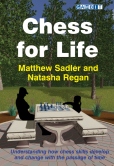
Chess for Life by Matthew
Sadler & Natasha Regan
2016
Gambit
Publications Ltd
http://www.gambitbooks.com
E-mail info@gambitbooks.com
222 pages
Price €21,60
ISBN 978-1-910093-83-2
Seldom I have seen such a brilliant chess guide as this work
from Matthew Sadler and Natasha Regan on in depth chess analysis,
interviews, statistics covering chess activity and results.
So far I am aware of this is the first book that discusses the
possibility of experience players who are considering to make a
comeback to chess after a break.
But there is more as players who are looking to revamp or expand their
opening repertoires.
And of course simple chess lovers who are interested in a good read on
chess.
Yasser Seirawan tells in his interview: My own style worked well
against Tal.He was an attacker and I knew the attack was coming, he
couldn’t contain himself and blasted open the position.I was ready for
it!
Tal was a long-time hero of mine,I had read and re-read his book Life
and Games of Mikhail Tal and his book on the 1960 World Championship
match.On a first reading I just though
“Wow!”and on a second reading “I still have a lot to learn about chess”.
Interesting are Seirawan words on the books from Nimzowitsch:
Personally I found Nimzowitsch unreadable.His ideas on overprotection
were over the top.He wasn’t the first person to play
prophylactically.For some people,though,this book is the cat’s
meow.I’ve been told that Nimzowitsch is much better in the original
German but some of the humour and nuances have been unavoidably lost in
the translation.’
Pia Cramling writes:”When I play chess,it makes me happy.For me it
would be very difficult to think of a life without chess.I really enjoy
the playing itself and the competion.It can be a championship or it can
also be a small tournament with a good atmosphere, friendly people or a
tournament I can go together with my family.”
Wise are words from John Nunn on the question do you have any practical
tips for club players who are looking to improve their game?
It is probably better not to experiment with your openings.A lot of
people get poorer results then they need to because they chop and
change there openings too much.
For professional players who are going to be prepared for very
carefully, that’s a different matter.
Keith Arkell provides us with another unusual way of traing.He enjoys
watching blitz games between top-class players as a way of training his
positionaland stratgic instinct.
Keith Arkell: “I watch Carlsen and Andreikin play blitz.At that speed
they have to play the move that would be right if the calculations
worked-they have no time to calculate.I never heard anyone else say
they study chess in this way.This is what I do when others prepare
openings.”
And Matthew Sadler likes to train….in the train…against strong computer
programs on his mobile phone.
Conclusion: This is a super
read!
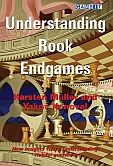 Understanding Rook Endgames
by Karsten Müller and Yakov Konoval
2016
Gambit
Publications Ltd
Understanding Rook Endgames
by Karsten Müller and Yakov Konoval
2016
Gambit
Publications Ltd
http://www.gambitbooks.com
E-mail info@gambitbooks.com
287 pages
Price €26,95
ISBN 978-1-910093-81-5
Grandmaster Karsten
Müller and his companion the well known Yakov Konoval have managed
to create a rook endgame book that is so unbelievable good written,
that we can speak from a work that will knock you down!
Yakov Konoval and his co worker Marc Bourzutschky have crated special
software which provides the reader with additional information as
longest wins,zugzwangs,typical positions and more.
Chapter four deals with the seven man endings in detail, sorted by pawn
configuration as both authors explain, they are often so deep that
pre-table analysis almost contains mistakes.
Many new discoveries are revealed here. Chapters 1-3 contain the five
man and six man endings that a club or tournament player should know.
By the way the international collaboration between Marc and Yakov for
the creation and the analysis of seven man Tablebases started in mid
2005.Yakov developed the generator,and Marc worked on the program to
verify the constructed tablebases {it guarantees almost absolute
correctness of tablebases}and a number of utilities to extract
information from tablebases.
But first a contents view:1,Rook and Pawn vs Rook 2,Rook and Two Pawns
vs Rook 3.Rook and Pawn vs Rook and Pawn, 4,Rook and two Pawns vs Rook
and Pawn 5,Principles of Rook Endings 6,Theoretical Endgames 7,Historic
8,Double Rook Endings and of course a collection of highly instructive
exercises to see if you have understood the lessons of grandmaster
Karsten Müller,that I consider as the greatest endgame expert of
this time!
Both authors show us in section 4.14 the weak sides of chess
engines,even that modern chess engines are very strong,they play above
grandmaster level,they some times have there weaknesses as the authors
explain:The main problem is that chess engines face is that sometimes
there deep calculating ability is irrelevant to appreciating a critical
point,even one that might be intuitively obvious in human termans
{e.g.,”this will never become possible”}.
A fine example is White:Kd4 Rb5 Pawns a5 and h5
Black Kf4 Rh7 Pawn a7
55….Kf3? And this loses in 30 moves, instead 55….Rh6! draws.
Conclusion: One of the best endgame
books of all time!
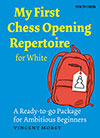
My First Chess Opening Repertoire for White
A Ready-to-go Package for Ambitious Beginners
by Vincent Moret
New in
Chess
http://www.newinchess.com/
170 pages
Price $ 19.95
ISBN: 978-90-5691-633-6
Vincent Moret
provides the user of this book with a well thought razor sharp,
white repertoire book based on lines as for example the famous
Möller Attack,that runs with the moves: 1.e4 e5 2.Nf3 Nc6 3.Bc4
Bc5 4.c3 Nf6 5.d4 exd4 6.cxd4 Bb4+ 7.Nc3 Nxe4 8.0-0 Bxc3 9.d5 Bf6
10.Re1 Ne7 11.Rxe4 d6 12.Bg5 Bxg5 13.Nxg5 0-0 14.Nxh7 Kxh7.
A interesting model game in this position is Bellaiche,Elise (1630) -
Monpeurt,Cyrielle (1750) [C54]
FRA-ch op-C Aix les Bains (8), 21.08.2007
1.e4 e5 2.Nf3 Nc6 3.Bc4 Bc5 4.c3 Nf6 5.d4 exd4 6.cxd4 Bb4+ 7.Nc3 Nxe4
8.0-0 Bxc3 9.d5 Bf6 10.Re1 Ne7 11.Rxe4 d6 12.Bg5 Bxg5 13.Nxg5 0-0
14.Nxh7 Kxh7 15.Qh5+ Kg8 16.Rh4 f6 17.Bd3 f5 18.Be2 Ng6 19.Qh7+ Kf7
20.Rh6 Qg5 21.Rxg6 Qxg6 22.Bh5 Qxh5 23.Qxh5+ Kg8 24.Re1 Bd7 25.h3 Rae8
26.Rxe8 Rxe8 27.Qf3 Re1+ 28.Kh2 Rb1 29.Qb3 b6 30.Qc3 Be8 31.Qxc7 Rxb2
32.Qxa7 Rxf2 33.Qxb6 Rxa2 34.Qxd6 Rd2 35.Qe7 Bb5 36.Qe6+ Kh8 37.Qxf5
Bd3 38.Qf4 Rd1 39.d6 Bg6 40.Qh4+ Kg8 41.Qd8+ Kh7 42.d7 Bf5 43.Qh4+ 1-0.
The future French junior champion crumbles under the pressure with
20…Qg5??
As our author explains: This type of defence is very difficult to play,
especially for players who are not grandmasters. On move 18.white
should have played the move from Keres18.Rh3!
Moret does not overload you with memorizing a Hugh amount of moves, no
the author explains the typical plans and ideas that belong to the
repertoire lines.
He also prefers the games of young improving players above perfect
played grandmaster games.
Other exciting lines are The Traxler Gambit, named after the Czech
Catholic priest and strong chess player Karel Traxler,who lived in the
late nineteenth century.
It all runs with the moves 1.e4 e5 2.Nf3 Nc6 3.Bc4 Nf6 4.Bg5 Bc5!? And
for all experts under us the secrets of Maarten de Zeeuw are included!
Against the French Moret goes for a King’s Indian set-up which was once
the pet line of the great Bobby Fischer but it is not my cup of thee!
No than I prefer more a play as the Night Attack of the Caro-Kann
1.e4 c6 2.d4 d5 3.e5 Bf5 4.h4!? h6 5.g4!
Conclusion: This book is overloaded with sharp excitement!
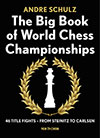
The Big Book of World Chess Championships
46 Title Fights – from Steinitz to Carlsen
by André Schulz
New
in
Chess
http://www.newinchess.com/
350 pages
Price $ 22.95
ISBN: 978-90-5691-635-0
The well known ChessBase author Andre Schultz describes in a
fascinating read the story of the 46 title fights for the world
championship in chess.
In for the first time in chess there is a good overview of the price
money and the conditions that belong to it.
But Andre Schultz also digs in the social background and does not fear
to cover in a objective way the psychological wars on and of the board,
this all is
included with excellent analysed games.
We all know how wonder boy Magnus Carlsen became multi millionaire, but
how different was it in the time with our first world champion Wilhelm
Steinitz 1836-1900 who lived nearly all his life in poverty.
The first player that made use of seconds was the great Emanuel Lasker
with his match against Siegbert Tarrasch in Munich 1908.
Andre Schultz writes:For the first time in the history of the World
Chess Championship a player was supported by masters as his
seconds.Lasker engaged as his helpers in the preparation for the match
the Austrian Heinrich Wolf and the Russian Simon Alapin.
The latter also gave on the 27th August 1908 in the restaurant of the
Kunstpalast a blindfold simultaneous exhibition for the entertainment
of the spectators. In addition Lasker was also supported by his brother
Berthold.Berthold Lasker also worked the demostration board in a
neighbouring room together with Rudolf Spielman.
Jacques Mieses,who was commenting on the games,also sat there.Tarrasch
was supported in Munich by his son Fritz Tarrasch.But Tarrasch and
Lasker had in addition agreed not to make use of outside help in
analysing adjourned games.
Lasker demanded for the WCh match first of all an honorarium of 15000
marks but than contended himself with 7500 marks {according to today’s
purchasing power that is the equivalent of approximately 35000 to 40000
euros}
Tarrasch did not insist on a honorarium so as to enable the match to
actually take place.Moreover a prizefund of 6500 marks was made
available by the German Chess Federation, of which 4000 marks would go
to the winner,2500 to the loser.
One of my favourite matches is the World championship match of 1937,for
more information please see Extreme Chess World Championships 1935,1937
and 1972 from CJS Purdy.
Conclusion: Books like these are seldom!
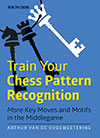
Train Your Chess Pattern
Recognition
More Key Moves & Motifs in the Middlegame
by Arthur Van de Oudeweetering
New in Chess
http://www.newinchess.com/
283 pages
Price $ 22.95
ISBN: 978-90-5691-613-8
The well known Arthur van de Oudeweetering presents in this book
a Hugh selection of positions based on the strategy of recognizing
positions, as we for example can see in the following example where the
white knight goes surprisingly for the black pawn on f7.
1.e4 e6 2.d4 d5 3.Nc3 dxe4 4.Nxe4 Bd7 5.Nf3 Bc6 6.Neg5 Nd7 7.Nxf7 Kxf7
8.Ng5+ Ke8 9.Bc4 Bd5 10.Nxe6 Bxe6 11.Bxe6 Bd6 12.0-0 Ngf6 and white has
huge positional compensation.
Hope you don’t fall into the ladies first pattern, as the former world
champion candidate GM Jan Timman did: Navara,David (2729) - Timman,Jan
H (2593) [E11]
Tata Steel-B 77th Wijk aan Zee (6), 16.01.2015
1.d4 Nf6 2.c4 e6 3.Nf3 Bb4+ 4.Nbd2 0-0 5.a3 Be7 6.e4 d5 7.e5 Nfd7 8.Bd3
c5 9.h4 g6 10.h5 cxd4 11.Nb3 dxc4 12.Bxc4 b5 13.Bd3 Bb7 14.Qd2 Nxe5
15.Nxe5 Qd5 16.Nf3 g5 17.Nxg5 f5 18.Rh3 Qxg2 19.Bf1 1-0.
Arthur van de Oudeweetering instructively writes after 14.Qd2!?
Violating the basic rules of development,white sets up a reversed
battery with the queen as the formost piece.However,you will soon get
used to this way of blocking the bishop’s diagonal.14.Bh6 would have
been the automatic move,developing with tempo.Yet Navara,having opted
for a straightforward opening set-up, consistently continues with the
caveman approach. Concrete calculations do the talking here.
14.Qd2 may come as quite a suprice,but Timman could have been
forewarned by the quite similar example in the same line:11.cxd5 Nc5
12.Bb1 exd5 13.b4 Ne6 14.Nb3 Nc6 15.Qd2! and black was equally helpless
in Miroshnichenko- Andreev,Al Ain 2013.
A classic example is Reti’s Rifle known from the famous game Reti –
Yates New York 1924.
Included throw the book are useful exercises to see if you have
understood the strategies of chess pattern recognition.
Conclusion: This is a super
instructive learning book!
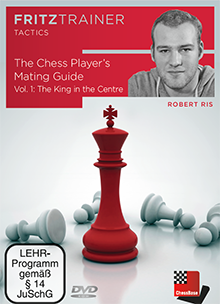
The
Chess Player’s Mating Guide Vol. 1: The King in the Centre
by Robert Ris
2016
http://www.chessbase.com
E-Mail info@chessbase.com
Price Euro 29.90
Pentium-Processor at 300 Mhz or higher, 64 MB RAM,
Windows XP, Windows
Vista, Windows 7, DVD drive, mouse, soundcard
Robert Riss learns you on this DVD how to bring your king
in safety by castling, how to reach the maximum of your king
possibilities.
This is all well packed in 10 chapters, 20 illustrative games and
key themes plus 10 training exercises,to see if you have understood the
techniques of play.
A fine example for every new comer is Morphy,Paul - Isouard,Carl [C41]
Paris it Paris, 1858
1.e4 e5 2.Nf3 d6 3.d4 Bg4 4.dxe5 Bxf3 5.Qxf3 dxe5 6.Bc4 Nf6 7.Qb3 Qe7
8.Nc3 c6 9.Bg5 b5 10.Nxb5 cxb5 11.Bxb5+ Nbd7 12.0-0-0 Rd8 13.Rxd7 Rxd7
14.Rd1 Qe6 15.Bxd7+ Nxd7 16.Qb8+ Nxb8 17.Rd8# 1-0.
Included is an extra database with 80 attacking games ,where I found
the following short cut: Chigorin,Mikhail - Burn,Amos [C30]
Ostend Ostend (18), 1905
1.e4 e5 2.f4 Bc5 3.Nf3 d6 4.c3 Nf6 5.Bc4 Nc6 6.d3 0-0 7.Qe2 Re8 8.f5 d5
9.Bb3 Bxf5 10.Bg5 dxe4 11.dxe4 Bxe4 12.Qc4 Qd5 13.Qb5 Bf2+ 0-1.
Video running time is a impressive 5 hours.
Conclusion: A must for all starters in chess!
 Beat the Queen's
Indian: The modern Fianchetto Line
Beat the Queen's
Indian: The modern Fianchetto Line
by Simon Williams
2016
http://www.chessbase.com
E-Mail info@chessbase.com
Price Euro 29.90
Pentium-Processor at 300 Mhz or higher, 64 MB RAM,
Windows XP, Windows
Vista, Windows 7, DVD drive, mouse, soundcard
The well known chess crack Grandmaster Simon Williams
provides the use of this DVD with a well made repertoire line based on
the Queen’s Indian with 1.d4 Nf6 2.c4 e6 3.Nf3 and g3!A old option is
the Benoni type move 4…c5 but as we can learn from Simon Williams it
contains some tactical traps but nothing more!
A fine example what you can expect is: Riazantsev,Alexander (2674) -
Karjakin,Sergey (2739) [E15]
11th Karpov Poikovsky RUS (8), 10.06.2010
[Simon Williams]
Main Line 10 Qe4!?
Sick of playing against the Nimzo Indian? Well do not fear as the
Queens Indian can be an aggressive and exciting alternative! 1.d4 Nf6
2.c4 [2.Nf3!? is an interesting move order that aims to stop the plan
that Black employed in this game. We wont be taking a deep look at
this, because 2 c4 is our main line. The idea though is 2...e6 3.g3 b6
(3...d5 is one potential problem with this variation as now White is
commited to playing a Catalan system; 3...c5 could also be another
slight problem as now d5 is not possible.) 4.Bg2 and now 4...Ba6?!
makes no sense, and after(4...Bb7 5.c4 we are back into another
variation, looked at later in the DVD) ] 2...e6 3.Nf3 b6 4.g3 One of
the most natural ways to play against ...b6. The bishop on g2 creates
numerous tactic threats to Black along the long diagonal. Giri once
said something along the lines, 'A fionchettoed bishop that is guard by
a king is always stronger than a fionchettoed bishop on the queenside
not defended.' This is an interesting point worth bearing in mind.
4...Ba6!? This is considered to be the main line, so we are going to
dive into the deep end and start with this move. On first sight this
looks odd, but the whole point of ...Ba6 is to try and misplace a White
piece or pawn. 5.Qc2! This trendy and rather new move causes Black the
most problems. [5.b3 is the other main alternative but play is often a
bit slower after this move, for example, 5...Bb4+!? again aimed at
misplacing a White piece. 6.Bd2 (6.Nbd2?! Bc3 7.Rb1 Bb7!³) 6...Be7
7.Bg2 c6;
5.Nbd2 will be briefly looked at later on in this DVD.;
5.Qa4 is sometimes played, but after 5...c5 White's powerful idea of d5
does not work so well. d5 works better with a queen on c2, as threats
of Qe4 at some point really come to life.] 5...Bb7 The bishop now drops
back. Black is figuring that the white queen is misplaced on c2.
[5...c5 Can lead to a less studied but interesting position after 6.d5
exd5 7.cxd5 Bb7 8.e4! this move will be looked at later on.] 6.Bg2 c5
7.d5! We will be concentracting on this strong and interesting pawn
sacrifice. [7.dxc5 is safer and looked at briefly later on. If you do
not want to sacrifice, then maybe this is the move for you.;
7.0-0 is fine for Black after 7...cxd4 8.Nxd4 and Black is able to swap
off White's strong bishop on g2. 8...Bxg2 9.Kxg2=] 7...exd5 8.cxd5 This
is the main line, but there is an extremly interesting and rare
alternative to this move in [8.0-0!?N Is a new move which we will look
at later. Let's first build the foundations.] 8...Nxd5! The best move.
This knight will often drop back to c7 and even e6, which is a solid a
good defensive square. [8...Bxd5?! was orginally played here, but the
bishop is simply a target on d5, again we take a look at this move
later. 9.Nc3] 9.0-0 White has compensation. This position has become
heavily anaylised now, we will take a look at some games in it to
understand things better. 9...Be7 10.Qe4!? One of the practical
problems Black faces when taking on the 5 Qc2 pawn sac is that there
are several approaches by White, and all of them contain at least some
danger. So even if you are confident as Black that you have been able
to patch up one line, there's the danger you will get hit from another
angle. [10.Rd1 is the main move for White, and will be looked at after
this.] 10...Na6 Alternatively: [10...Bc6! seems like the safest option,
which currently leads to an equal position. 11.Ne5 Nf6! Simplfying in
this manner is best. (11...Nc7?! 12.Nxc6 dxc6? (12...Nxc6 13.Nc3)
13.Nc3 0-0 14.Rd1± was already very good for White
-Shirov-Jakovenko, Foros 2008.) 12.Nxc6 Nxc6 13.Qa4 (13.Qf5!? is worth
investigating as a new idea for White. The idea is to try and make
Black play either ...g6 or ...Nd4.
...g6 weakens the kingside position for Black and ...Nd4 will be hit by
e3 later, when White gains some time. 13...0-0 14.Rd1 Nd4 15.Qd3 Rc8
16.Nc3 White has compensation, but it will be a long game.) 13...0-0
14.Rd1 Nd4!? 15.Nc3 b5 16.Qa6 b4 17.Nd5 Nxd5 18.Bxd5 Rb8 19.Bf4 Qb6
20.Qc4 White's activity and light-squared blockade gives White enough
for the pawn, but it's questionable whether it offers any more.
Both Leko and Karjakin, however, have preferred 10...Na6, but this
seems very risky.;
10...Qc7? 11.Nh4!± A typical idea in this variation. The knight
comes to f5 and White increases the pressure on the long diagonal.
(this is also strong against 10...Qc8?) 11...0-0 (11...Bc6 was played
against me, but I quickly got a very good position after 12.Bg5?! a bit
too flash. (12.Nf5! simple and strong.) 12...Kd8 13.Nc3 Nf6 14.Qf5 Qd6
15.Rfd1 Qe6 16.Qd3 h6 17.Be3 Bxg2 18.Nxg2 g5 19.b4!? 1-0 (35)
Williams,S (2506)-Nemeth,M (2452) Dublin 2012) 12.Nf5 Bf6 13.Rd1 left
Black in some trouble in L.Pantsulaia-T.Sakelsek, Istanbul 2007.;
10...0-0?! is also unwise because of 11.Rd1!±;
10...Qc8?! 11.Nh4!] 11.Nh4! The critical test and one of the main ideas
behind Nh4. 11...g6 This seems like it stops Nf5 but... [11...0-0
12.Nf5 Bf6 13.Qg4 is quite dangerous for Black, for example, 13...Kh8
14.Rd1 Nac7 15.e4 with an attack.] 12.Nf5! The first new move, but
White is actually following a line given by Karjakin in 'Chess
Informant 103', in his notes to his game with Peter Svidler. [12.Qe5
has been previously played, but this does not seem as strong, for
example, 12...f6 13.Qe4 Qc8 14.Rd1 Nac7 15.Nxg6 hxg6 16.Qxg6+ Kd8 White
is attacking but Black has lots of pieces defending.] 12...gxf5 13.Qe5!
An important nuance. [13.Qxf5? Nac7! is good for Black.] 13...0-0! [If
13...f6? 14.Qxf5 Black cannot keep his extra piece, since here
14...Nac7 is met by 15.Qh5+ and Black is unlikely to survive the
onslaught after 15...Kf8 16.Bh6+ Kg8 17.Qg4+ Kf7 18.Qg7+ Ke6 19.e4!]
14.Qxf5! Playing with ambitious intentions. [There's nothing obviously
wrong with 14.Bxd5 , but after 14...Bf6 15.Qxf5 Bxd5 16.Qxd5 Nb4 17.Qf5
Qe7= Black's activity makes up for his slightly weak king. In fact
White spurns two further opportunities to take on d5 in the quest to
keep Black under as much pressure as possible.] 14...Re8 [14...Bf6
15.Nc3 Nac7 16.Be4 Re8 transposes to the game;
Black needs to avoid 14...Nac7? 15.Be4!] 15.Nc3!? Nac7 16.Be4!? There's
no way back now! 16...Bf6 17.Qxh7+ Kf8 18.Bxd5! Bxd5! Great attacking
and defending! [18...Nxd5? loses to 19.Bh6+ Ke7 20.Qe4+ Kd6 21.Bf4+!
Nxf4 22.Nb5#] 19.Nxd5 Nxd5 20.e4! Nc7! [If 20...Nb4 then 21.Bh6+ Ke7
22.e5 intending 22...Bxe5 23.Bg5+ Bf6 24.Qh6 is very strong.] 21.Bh6+
Ke7 22.e5! Opening up more lines. 22...Bxe5 23.Qe4! f6 [23...Kf6? is
met by 24.Bg5+!! Kxg5 25.f4+ , as indicated by Golubev in 'Chess
Today'. He gives 25...Kh6 26.fxe5 d5 27.Qg4 Rxe5 28.Rxf7 Qg5 29.Qh3+
Qh5 30.Qd7 Qg6 31.Raf1! Ne8 32.Rf8 Qg7 33.Qc6+ and White wins.] 24.f4
d5 25.Qh7+ Kd6 26.fxe5+ fxe5 Black's king crucially support his strong
pawn centre!
This line maybe playable for Black, but it is not as simple as ...Bc6
instead of ...Na6. There are so many bullets that Black needs to dodge
in this variation! 27.Rf7 Ne6 28.Qg6 Kc6 29.Raf1± d4?!
"Certainly not the best, but I am afraid that it can be already hard to
suggest a good way for Black" - Golubev. Having to find the most
accurate defence, move after move, is a challenge that very few can
meet. 30.R1f6 Qd5 31.Rxa7! Why not? 31...Rad8 32.a4?! Not needed.
[32.Qf7!+- as more to the point when White is winning, for example,
32...Kb5 33.b3! d3 34.Bd2 Qd4+ 35.Rf2 e4 36.a4+ Kc6 37.Qb7+ Kd6
38.Bf4+] 32...c4 33.Qf7? [The computer wants to play 33.Bf8!!
threatening Qf7, and winning after 33...Rxf8 34.Rxe6+ Rd6 35.Qh7! as
indicated by Golubev.] 33...Kc5 34.Bd2 c3 35.Rc7+? Kb4 36.bxc3+ Kb3?
[36...dxc3! 37.Bxc3+ Ka3÷] 37.c4 Qd6 38.Rb7? d3!µ Suddenly
Black's king, which up till now has been causing him so many problems,
becomes an irresistible attacking force! 39.a5 Qd4+ 40.Kf1 Qe4 41.Kg1
Kc2! 42.Rxb6 Kxd2 43.Rbxe6 Rxe6 44.Qxe6 Kc2 45.c5 Qd5! 46.Qg4 Qd4+
47.Rf2+ d2 48.Qf3 e4 49.Qf7 Kc3 A win for Black in the end, but only
after White missed several possibilities and a clear win with 33 Bf8!.
This is a seriously scary line for Black. 0-1.
And there are 19 of these deeply analyses on this DVD!
Plus an extra database of 60 entries where a small 28 of them are well
analysed.
All highly instructive packed in 7 hours English video time.
Conclusion: One of those super made ChessBase openings DVD’s!
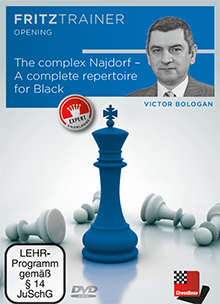 The complex Najdorf
The complex Najdorf
by Viktor Bologan
2016
http://www.chessbase.com
E-Mail info@chessbase.com
Price Euro 29.90
Pentium-Processor at 300 Mhz or higher, 64 MB RAM,
Windows XP, Windows
Vista, Windows 7, DVD drive, mouse, soundcard
Grandmaster Victor Bologan provides the user of this DVD with a
compressive study of the whole Najdorf variation as the Poisoned Pawn
and English Attack plus several lines between it.
A fine example of this all is: 6.Bg5-7.f4-9.Qd2 [B96]
1.e4 c5 2.Nf3 d6 3.d4 cxd4 4.Nxd4 Nf6 5.Nc3 a6 6.Bg5 e6 7.f4 h6 8.Bh4
Qb6 9.Qd2 Qxb2 10.Rb1 [10.Nb3 Be7 11.e5 dxe5 12.a3 (12.Rb1 Ne4)
12...exf4 13.Bf2 Nd5 14.Bd4 Bh4+ 15.g3 fxg3 16.hxg3 Guseinov G 2584 -
Nielsen PH 2670 , 24.3.2011 12th ch-EUR 16...Nc6-+] 10...Qa3 11.e5
[11.f5 Be7 12.fxe6 (12.Bg3 e5 13.Nb3 Nbd7 14.Bd3 b5 15.0-0 0-0)
12...fxe6 13.Bc4 (13.Be2 0-0 14.0-0 Nc6 15.Nxc6 bxc6 16.Rf3 Qa5 17.Kh1
Qc7 18.Rbf1 Bb7 19.e5 dxe5 20.Bxf6 Rxf6 21.Rxf6 Bxf6³ Padmini R
2345 - Wang Jue 2364 , 13.5.2012 Asian Continental w 2012) 13...Nxe4
14.Nxe4 Bxh4+ 15.g3 Bg5 16.Nxg5 hxg5 17.Rb3 (17.c3 Qc5 18.Bxe6 Qe5+
19.Qe2 Nc6; 17.Nxe6 Bxe6 18.Bxe6 Qxg3+ ! 19.hxg3 Rxh1+ 20.Ke2 Rh2+
21.Ke1 Rxd2 22.Kxd2 Ra7³ Vallejo Pons F 2698 - Morozevich A 2700 ,
2.1.2011 53rd Masters) 17...Qc5 18.Rc3 (18.Bxe6 Nc6 19.Bxc8 Nxd4;
18.Rf1 !? 18...Nc6 19.Nxe6 Bxe6 20.Bxe6 Qe5+ 21.Re3 Qa1+ 22.Ke2 Rxh2+
23.Rf2 Rxf2+ 24.Kxf2 Qd4 25.Bd5+ Kd8) 18...Nc6 ! 19.Nxc6 ?! (19.Bxe6
Qe5+ 20.Re3 (20.Qe3 Bxe6 21.Nxe6 Kd7 22.Qxe5 Nxe5 23.Nxg5 Rae8³)
20...Nxd4 21.0-0 Bxe6 22.Rxe5 dxe5³) 19...bxc6µ Lu, Shanglei
2542 - Wei, Yi 2453 , ? 2012 China (ch) 116/86;
11.Be2 Be7 12.0-0 Nbd7 13.f5 (13.Rf3 Qc5 14.Bf2 Qc7 15.Rg3 g5 16.fxg5
hxg5 17.Rxg5 b5) 13...e5 14.Nb3 0-0 15.Rf3 Nxe4 16.Nxe4 Bxh4 17.c4 Qa4
18.Nxd6 Qc6 19.Rd1 Rd8;
11.Bxf6 gxf6 12.Be2 (12.f5 Nc6 13.fxe6 fxe6 14.Be2 Nxd4 15.Qxd4 Be7
16.Bh5+ Kd8) 12...h5 13.0-0 Nd7 14.Kh1 (14.f5 Bh6 15.Qd3 Ne5 16.Qh3 Qc5
17.Rfd1 b5 18.Kh1 Ng4 19.Bxg4 hxg4 20.Qxg4 Qxc3) 14...Be7 15.Rf3 Qa5
16.Rh3 h4 17.Bg4 Nc5 18.Nb3 Nxb3 19.cxb3 Bd7 20.b4 Qb6 21.Rd3 Rc8³
Ter Sahakyan Samvel (ARM) 2558 - Ochsner Bjorn Moller (DEN) 2258,
Albena (Bulgaria) 45.01/0 ] 11...dxe5 12.fxe5 Nd5 [12...g5 second
option 13.exf6 (13.Bg3 Nh5 14.Ne4 Nd7 15.Rb3 Qxa2 16.Be2 Qa1+ 17.Bd1
Nc5 18.Nxc5 Nxg3 19.Rxg3 Bxc5 20.c3 Bd7; 13.Bf2 Ng4 14.Bg3 Nd7 15.Be2
Ngxe5 16.0-0 Bg7 17.Nxe6 fxe6 18.Ne4 Rf8 19.Bh5+ Ke7 20.Rb3 Rxf1+
21.Kxf1 Nc4 22.Rxa3 Nxd2+ 23.Nxd2 Be5µ Anand V 2788 -
Nepomniachtchi I 2632 , 7/31/2009 14th WCh-Rapid Prelim) 13...gxh4
14.Be2 Qa5 15.0-0 Nd7 16.Kh1 a) 16.Qd3 Qe5 17.Ne4 (17.Kh1 h3 18.g3 Nxf6
19.Bf3 Be7) 17...Nc5 18.Nxc5 Bxc5 19.c3 h3 20.g3 Bd7 21.Rxb7 Ter
Sahakyan S 2558 - Swiercz D 2553 , 14.8.2011 50th World Juniors
21...Bb5 22.Qf3 Bxd4+ 23.cxd4 Qxd4+ 24.Kh1 0-0 25.Bxb5 axb5³; b)
16.Nb3 Qg5 17.Ne4 Qxd2 18.Nbxd2 Nc5; c) 16.Rf4 h3 17.Nb3 Qb6+ 18.Nd4
Qc7 19.Qe3 Qe5 20.Ne4 Bc5; 16...Qg5 ! 17.Rf4 (17.Qe1 Nxf6 18.Nf3 Qg7
19.Nxh4 Be7 20.Rb3 h5 21.Bf3 Ng4 22.Bxb7 Bxb7 23.Rxb7 Qe5 24.Nf3 Qxe1
25.Rxe1 Rc8 26.Ne4 Kf8 27.h3 Rh6 28.a4 Rc4 = Merrheim, Xavier 2115 -
Glatthaar, Michael 2117 , ICCF WS/M/375 5.04/0 ) 17...e5 18.Nd5 exd4
19.Qxd4 a) 19.Nc7+ Kd8 20.Nxa8 d3 ! 21.Bxd3 Bd6 22.Rbf1 Bxf4 23.Rxf4 h3
(23...Re8) 24.gxh3 Qd5+ 25.Qg2 Qd6³ Bromberger S 2530 -
Areshchenko A 2664 , 11.12.2010 Schachbundesliga 2010-11; b) 19.Bf3 Bd6
20.Qxd4 Ne5 21.Ne7 Nxf3 22.Qxd6 h3 23.g3 Qe5 24.Nxc8 Rxc8 25.Qb4 Rc5
26.Qxb7 0-0 1/2-1/2, Rasmussen, Erik 2336 - Teichmann, Cenek 2398 ,
ICCF 15.5.2012 VWC3/sf04 27.Qxf3 Rxc2 =; 19...Kd8 20.Ne7 a) 20.Rd1 h3
21.g3 (21.gxh3 Bc5 22.Qd3 Re8 23.Bf3 Re6 24.Qh7 Qg6 25.Qxg6 fxg6 26.f7
a5 27.Bg4 Raa6 28.Rc4 Bf8 29.Bxe6 Rxe6 30.Nf4 Re7 31.Nd5 Re6 =
Ponjican, Ing. Erich - Haas, Bernhard 2259 , ICCF 1.4.2012 AUT/Wien/C4
(AUT)) 21...Bd6 22.Re4 (22.Bg4 Bxf4 23.Bxd7 Bxd7 24.Qb6+ Ke8 25.Qb4 Kd8
=) 22...Re8 23.Nb6 Rxe4 24.Qxe4 Qc5 25.Nxa8 Nxf6 26.Qd3 Ke7 27.Bf3 h5
28.Qe2+ Be6³ Nisipeanu LD 2673 - Wojtaszek R 2711 , 31.3.2011 12th
ch-EUR; b) 20.Bg4 Bc5 21.Qd2 Bd6 22.Qa5+ b6 23.Rxb6 Bc7-+ Duda,J 2563 -
Wojtaszek,R 2713 , Warsaw POL 1.4.2014 ch-POL 2014; 20...Qe5 21.Qd2
Bxe7 22.fxe7+ Qxe7 23.Bg4 f5 24.Rxf5 Re8 25.Rd5 b6 26.h3 (26.Rd1 Ra7
27.Qf2 Rb7) 26...Kc7 27.a4 Ne5 28.Re1 Bxg4 29.hxg4 Qg7 = Domancich,
Ezequiel Martin 2304 - Glatthaar, Michael 2152 , ICCF WS/M/387 9.07/0 ]
13.Nxd5 exd5 14.e6 [14.Rb3 Qa4 15.e6 Bxe6 16.Qf4 g5 17.Qf6 (17.Qe5 Nc6
18.Nxc6 Rg8) 17...Rh7 18.Nxe6 fxe6] 14...Bxe6 15.Nxe6 fxe6 16.Bd3
[16.Be2 !? 16...Be7 17.Bh5+ Kd8 18.Bxe7+ Qxe7 19.0-0 Nd7 20.Rf7
(20.Rxb7 Qc5+ 21.Kh1 Rb8 22.Rxb8+ Nxb8 23.Qe2 Qb5 24.Qxb5 axb5 25.Rf7
Nc6 26.Rxg7 Rf8 27.Kg1 Nb4³ Shirov A 2710 - Hou Yifan 2605 ,
1.2.2012 Gibraltar Open) 20...Qc5+ 21.Kh1 Rf8 22.Rxg7 Rc8 23.Qxh6
(23.h3 Rc6 24.Qxh6 Kc8 25.Bg4 Qxc2 26.Re1 Qc3 = Kosintseva N 2560 - Hou
Yifan 2575 , 7.8.2011 Rostov Women GP) 23...Qb4 24.Qc1 Solak,D 2618 -
Zhigalko,S 2694 , Warsaw POL 11.11.2013 19th European Teams 24...Qf4 !
25.Qxf4 Rxf4 26.g3 Rf2 27.Rxb7 Rcxc2 ! 28.Rbxd7+ Kc8 29.Kg1 Rg2+ 30.Kf1
Rxh2 31.Kg1!;
16.Qe2 Qc3+ 17.Qd2 Qxd2+ 18.Kxd2 Hossain Enam 2516 - Safarli E 2587 ,
9/5/2009 4th Kolkata Open 18...b5 19.a4 (19.Bd3 Be7) 19...b4 20.Be2
Nc6] 16...Be7 17.Bg6+ Kd8 18.Bxe7+ Qxe7 19.0-0 [19.Rf1 Nd7 20.Rf7 Qc5
21.Rxb7 Ne5 22.Qf4 (22.Rxg7 Rf8) 22...Qg1+ 23.Kd2 Nc4+ 24.Kc3 Qa1+
25.Kd3 Qd1+ =] 19...Nd7 20.Rf7 [20.Rxb7 Qc5+ 21.Kh1 Rb8 22.Rxb8+ Nxb8
23.Qf4 Nd7³] 20...Qc5+ 21.Kh1 Rf8 22.Rxg7 Rf6 23.Qxh6 [23.Rg8+ Rf8
24.Rxf8+ Qxf8 25.c4 dxc4;
23.Bd3 Kc7 24.c4 (24.Qe1 Raf8 25.Qe5+ Qd6) 24...d4 25.Qe2 (25.Qe1 Raf8
26.Qe4 b6 27.Qh7 Rd8 28.h3 Naiditsch Arkadij (GER) 2727 - Yilmaz
Mustafa (TUR) 2577, Antalya (Turkey) 47.03/0 28...Kd6 29.Be2 Qe5 30.Bf3
Rxf3 ! 31.gxf3 Qe3 32.Qe4 (32.Rf1 d3) 32...Qxe4 33.fxe4 d3³)
25...Raf8 26.Qe4 R6f7 27.Qxb7+ Kd8 28.Rg4 (28.Rxf7 Rxf7) 28...Ne5
29.Qb8+ Ke7 30.Qb7+ Kd8 =] 23...Qf8 24.h3 Kc7 25.Qh7 Rf1+ = Line
For the good order there are 25 of these extensive lines!
Included are 58 well analysed model games,where I would like to end
with the following smashing example: Radjabov,Teimour (2682) -
Gelfand,Boris (2724) [B96]
EU-chT (Men) 15th Gothenburg (5.1), 03.08.2005
[Gelfand,B]
1.e4 Gofshtein 1...c5 2.Nf3 d6 3.d4 cxd4 4.Nxd4 Nf6 5.Nc3 a6 6.Bg5 e6
7.f4 Nbd7 8.Bc4 Qb6 9.Qd2 [9.Bb3 Be7 10.f5 Nc5 11.fxe6 fxe6 12.Na4
(12.Be3 -16/466) 12...Qc7 13.Nxc5 dxc5 (13...Qxc5 14.Be3 Qe5
15.0-0±) 14.Nxe6 (14.Bxf6 Bxf6 15.Nxe6 Qe5 16.Qd5 Qxe6 17.Qxe6+
Bxe6 18.Bxe6 Bxb2=) 14...Bxe6 15.Bxe6 Qe5 16.Bxf6 (16.Bf5 Rd8 17.Qf3 g6
18.Bf4 Qxb2-+) 16...Qxe4+ 17.Qe2 (17.Kf2 Qxe6 18.Bxe7 Qxe7 19.Re1 0-0+
20.Kg1=) 17...Qxe2+ 18.Kxe2 Bxf6= Radjabov,T-Gelfand,B/Merida,ESP-TCH
2005 ] 9...Qxb2 10.Rb1 Qa3 11.Bxe6?! Gofshtein: 'A relatively new idea
which was seen only in one game before. White sacrifices a piece and
gets a long-term initiative' [11.f5?! e5 12.Ne6 fxe6 13.fxe6 Nc5]
11...fxe6 12.Nxe6 Kf7 [12...Qa5 13.0-0 Kf7 (13...h6 Gofshtein 14.Bh4
Kf7 15.f5 Be7 16.Qd3 Ne5 17.Qh3 b5 18.Bxf6 Bxf6 19.Qh5+ Kg8
20.Nd5÷ 1-0 Beil,Z-Watzlawek,M/Sueder 1996/EXT 2001 (35)) 14.f5
-12...¢f7] 13.f5 [13.Nd8+ Kg8 14.0-0 (14.Ne6 Qa5 15.Nxf8 Kxf8
16.Qxd6+ Kf7; 14.Nxb7 Bxb7 15.Rxb7 Qc5-+ Olthof,R) 14...Qc5+ 15.Kh1 Qc4
16.Rfe1 h6µ;
13.e5 13...dxe5 14.fxe5 Nxe5 15.Nxf8 Rxf8 16.Bxf6 gxf6 17.0-0 Kg7-+
Olthof,R] 13...Qa5 14.0-0 14...b5! Gofshtein: 'Black opens the way for
his light squared bishop, trying to finish the development.' [14...Be7
15.Qe3 b5 16.Qg3f] 15.a4 [15.Nxf8 Rxf8 16.Qxd6 Re8-+] 15...Bb7!
Gofshtein: 'This way black activates his pieces on the queenside.'
[15...b4 16.Bxf6! (16.Nd5 Nxe4 17.Qd4 Bb7 18.Ndc7 18...d5 19.Nxa8
Bxa8-+ ) 16...Nxf6 17.Ng5+ Kg8 18.Nd5÷] 16.axb5 Rc8 17.bxa6 '?!'
Gofshtein. Gofshtein: '17.¦b3 deserved attention, not letting
the black bishop to get into the game.' [17.Rb3!? Gofshtein 17...axb5
18.Rxb5 Qxc3 19.Qxc3 Rxc3 20.Rxb7] 17...Bxa6 18.Rf3 Be7 19.Rg3 [19.Qe1
Bc4 20.Ra1 Qb6+ 21.Be3 Qc6 22.Ra7 Ne5 a) 22...Bxe6 23.fxe6+ Kxe6
24.Ne2!; b) 22...Rhe8 23.Qg3 Bf8 24.Bd4 (24.Nd4 Qb6) 24...Bxe6 25.fxe6+
Rxe6 26.Nd5 Rxe4µ; 23.Rg3 g6µ;
19.Qd1 Rxc3 20.Bd2 Rxf3 21.Ng5+ Ke8 22.Bxa5 Rf1+-+] 19...Rhg8 [19...Bc4
20.Bxf6 Bxf6 21.Qxd6 Qa7+ 22.Kh1÷;
19...Rc6 20.Qd1! (20.Nd5 Qxd2 21.Bxd2 Rg8 22.Ng5+ Ke8 23.Ra3 Bc8-+) ;
19...Nf8 20.Qd1!";
19...g6!? Olthof,R;
19...Rb8!? 20.Rd1 (20.Re1 Rhc8) 20...Rhc8 21.Bh4 Nh5 22.Bxe7 Nxg3
23.Qxd6 Qb6+ 24.Qxb6 Nxb6µ] 20.Qe1 [20.Bxf6 Nxf6 21.Ng5+ Ke8
'µ' Gofshtein. ;
20.Qd1!? Notkin,M 20...Bc4 (20...Rxc3 21.Bd2 21...Rgc8 (21...Nxe4
22.Qh5+ Kf6 23.Qh4+ Kf7= 24.Qxe4? Qa2 25.Rxc3 Qxb1+ 26.Kf2 Qf1+ 27.Kg3
Qe2) 22.Bxc3 ( 22.Qe1?! 22...Rxg3! 23.Bxa5 23...Ra3T 24.Bb4 Ra2 25.Qg3
Rcxc2 26.Qxg7+ Ke8-+ Olthof,R; 22.Rxg7+ Ke8 23.Bg5©) 22...Rxc3
23.Qe1 Ra3 24.Rxg7+ Ke8 25.Qxa5 Rxa5 26.Nc7+ Kf8 27.Ne6+= ) 21.Ra1
(21.Rb7 Ke8 (21...Bxe6 22.fxe6+ Kxe6 23.Bxf6 Nxf6 24.Nd5f) 22.Bxf6
(22.Bd2 Qa6) 22...Nxf6 23.Nxg7+ Kf8-+) 21...Qb6+ 22.Be3 Qc6 23.Ng5+
Ke8µ] 20...Bc4 21.Ra1 [21.Bd2 Bxe6 22.fxe6+ Kxe6 23.Nb5 23...Qb6+
24.Be3 Qd8-+ (24...Qa6 25.Bf2 Kf7 26.Ra3 Qc6 27.Rc3) ;
21.Rb7 Bxe6 22.fxe6+ Kxe6 23.Bxf6 Bxf6 24.Qd1 Rgd8!-+ Notkin,M]
21...Qb6+ 22.Be3 Qc6 23.Nd4 [23.Bd4 Bxe6 24.fxe6+ Kxe6;
23.Ng5+ Ke8 24.Bd4 (24.Nf3 Ne5) 24...h6 (24...Nh5 25.Rg4 Bf6-+) 25.Ne6
Kf7+-] 23...Qc7 24.Nf3 Rge8 25.Ra7 Qb8 26.Bd4 Bf8 27.Qc1 [27.Bxf6
Qxa7+] 27...Rc7 28.Ra5 Kg8 29.Qg5 [29.Qh6 Kh8] 29...Nxe4 30.Nxe4 Qb1+
31.Kf2 Qf1+ 0-1.
All well packed in 6 hours and 31 minutes English video time!
Conclusion: Smashing!
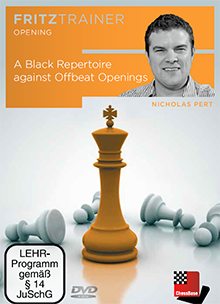
A Black Repertoire against Offbeat Openings
by Nicholas Pert
2016
http://www.chessbase.com
E-Mail info@chessbase.com
Price Euro 29.90
Pentium-Processor at 300 Mhz or higher, 64 MB RAM,
Windows XP, Windows
Vista, Windows 7, DVD drive, mouse, soundcard
Nicholas Pert explains you in this DVD how to tackle with black various
off beat lines as the Sokolski Opening,Nimzowitsch Larsen
Attack,Bird,1.King’s Fianchetto Opening,King’s Indian Attack,Blackmar
Diemer Gambit,Colle Zuckertort,Veresov,Trompovsky,Trompovsky and more!
All packed in 26 highly instructive video files,where the last ten are
divided to self tests.
A fine example against the Nimzo Larsen is Oset Teixidor,Guerau (1930)
- Perez Mitjans,Orelvis (2418) [A01]
Test 5 Cerdanyola del Valles op 31st Cerdanyola del Valles (5), 2013
1.b3 e5 2.Bb2 Nc6 3.e3 Nf6 4.Bb5 e4 5.d4 a6 [5...Ne7] 6.Bxc6 dxc6 7.c4
Bd6 8.Ne2 0-0 9.Nbc3 Re8 10.Qc2 Ng4 11.h3 Qh4 12.0-0 Nh2 13.c5 [13.Rfe1
Nf3+ 14.gxf3 exf3 15.Nf4 Bxf4 16.exf4 Bxh3] 13...Nf3+ 14.gxf3 exf3
15.cxd6 Qxh3 16.Nf4 Qg4+ 17.Kh2 Re6 18.Qxh7+ Kxh7 0-1.
Included is a extra database of 96 entries where I found the following
Grob game from our gambit hero Michael Basman: Basman,Michael J
(2330) - Giri,Anish (2776) [A00]
London Classic rapid op 6th London (5), 06.12.2014
1.g4 d5 2.h3 e5 3.Bg2 c6 4.d4 e4 5.c4 Be6 6.Nc3 Ne7 7.f3 Ng6 8.fxe4
dxe4 9.Bxe4 Bxc4 10.Nf3 Bb4 11.Qc2 Nd7 12.h4 Nf6 13.h5 Ne7 14.h6 gxh6
15.Bxh6 Nxg4 16.Bg5 Qa5 17.Rh4 h5 18.a3 Bxc3+ 19.Qxc3 Qxc3+ 20.bxc3 f6
21.Bd2 Kf7 22.Bc2 Rae8 23.e3 Ng6 24.Bxg6+ Kxg6 25.0-0-0 0-1.
Running time is just over 5 hours!
Conclusion: This is a super
buy!
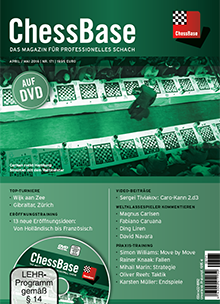
ChessBase Magazine issue 171
2016
April/May
http://www.chessbase.com
E-Mail
info@chessbase.com
ISSN 1432-8992
Price Euro 19.95
This eye catching ChessBase Magazine comes with top
tournaments as Wijk aan Zee, Gibraltar and Zurich, all well packed in a
heavy loaded tournament file of 971 entries, where a small 25 of them
cover heavy loaded annotations.
The openings surveys cover:
Marin: Reti/English Double Fianchetto A05
1.Nf3 Nf6 2.g3 g6 3.b3 Bg7 4.Bb2 d5 5.c4 dxc4 6.bxc4 c5 7.Bg2 0-0 8.0-0
Nc6,Schipkov: English A25
1.c4 e5 2.g3 Nc6 3.Bg2 g6 4.Nc3 Bg7 5.Rb1 Nf6,Szabo: King’s Indian -
London System A48
1.d4 Nf6 2.Nf3 g6 3.Bf4 Bg7 4.e3 0-0 5.h3 d6 6.Be2 b6 7.0-0 Bb7 8.c3
Nbd7,Moskalenko: Dutch A80
1.d4 f5 2.Nc3 d5 3.Bf4 a6,Gormally: French C06
1.e4 e6 2.d4 d5 3.Nd2 Nf6 4.e5 Nfd7 5.Bd3 c5 6.c3 Nc6 7.Ngf3,Langrock:
French C11
1.e4 e6 2.d4 d5 3.Nc3 Nf6 4.e5 Nfd7 5.f4 c5 6.Nf3 Nc6 7.Be3 cxd4 8.Nxd4
Bc5 9.Qd2 0-0 10.0-0-0 a6 11.Qf2 Qe7,Stohl: Grünfeld Reversed D02
1.Nf3 d5 2.g3 c5 3.Bg2 Nc6 4.d4 Nf6 5.0-0 cxd4 6.Nxd4 e5 7.Nxc6 bxc6
8.c4,Bronznik: Chigorin Defence D07
1.d4 d5 2.c4 Nc6 3.Nf3 Bg4 4.Nc3 e6,Kuzmin: Slav D10
1.d4 d5 2.c4 c6 3.Nc3 Nf6 4.e3 Bf5 5.cxd5 cxd5 6.Qb3 Nc6 7.Qxb7
Bd7,Krasenkow: Grünfeld Defence D85
1.d4 Nf6 2.c4 g6 3.Nc3 d5 4.cxd5 Nxd5 5.e4 Nxc3 6.bxc3 Bg7 7.Nf3 c5
8.Rb1 0-0 9.Be2 cxd4 10.cxd4 Qa5+ 11.Bd2 Qxa2 12.0-0 Bg4,
Postny: Catalan E01
1.d4 Nf6 2.c4 e6 3.g3 c5 4.Nf3 cxd4 5.Nxd4 d5 6.Bg2 e5 7.Nf3 d4 8.0-0
Nc6 9.e3 and at last Ris: Blumenfeld Gambit E10
1.d4 Nf6 2.c4 e6 3.Nf3 c5 4.d5 b5 5.e4.
Other contributions are: Openings Videos by Sergei Tiviakov Caro-Kann
1.e4 c6 2.d3 d5 3.Nd2,Simon Williams Anti Grünfeld 1.d4 Nf6
2.c4 g6 3.h4 and Sagar Shah English with 1.d4 d6 2.c4 e5 3.Nc3 exd4
4.Qxd4 Nc6 5.Qd2 Nf6.
Orther DVD columns are Williams: Move by Move,Rogozenco The
classic,Marin Strategy,Reeh Tactics,Klaus Müller Endgames with the
power of passed pawns,Knaak The opening trap.
Included is a readable booklet in two languages.
Conclusion:This is must have material!










